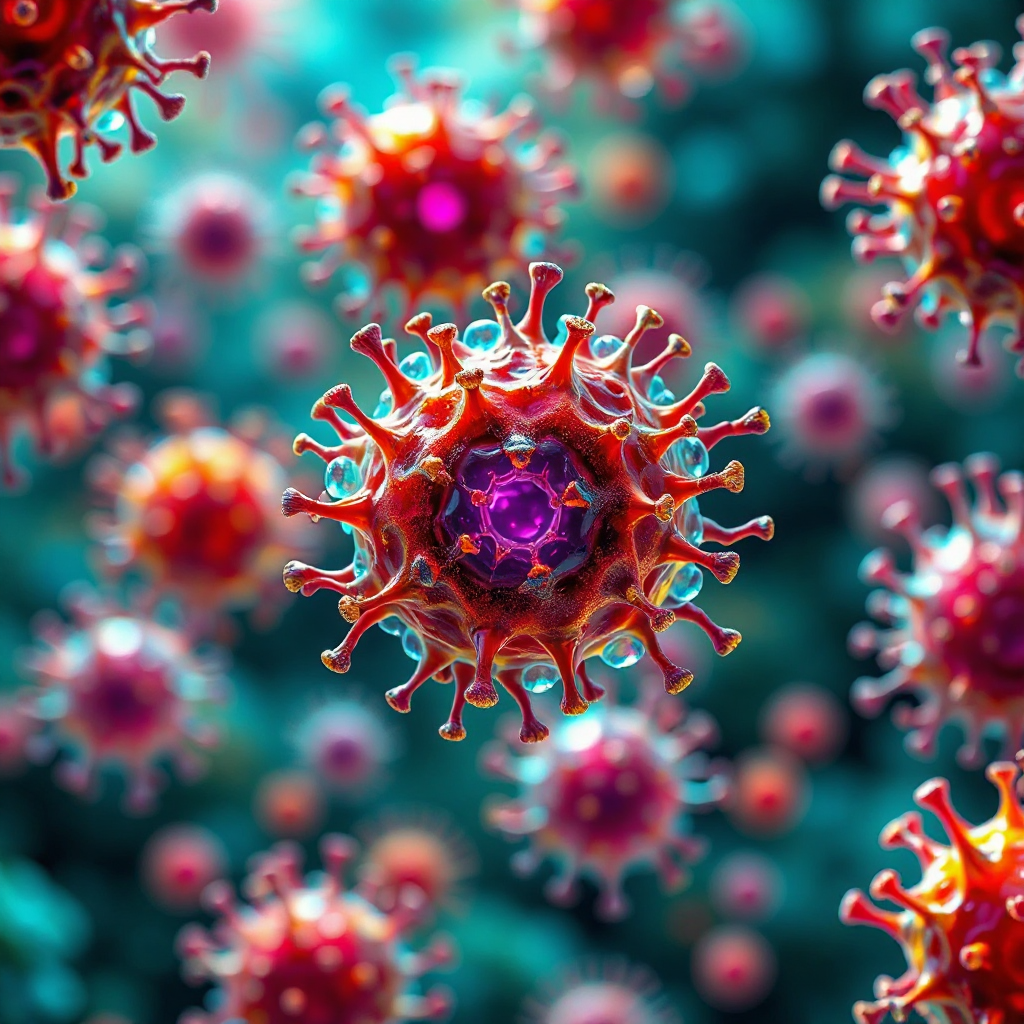Understanding Symptoms and Treatment of Lymphomatoid Granulomatosis

Lymphomatoid granulomatosis is a rare disease that primarily targets the lungs but can also affect your skin and brain. It occurs most often in adults between their 40s and 60s, with men being twice as likely to develop it as women. While its exact prevalence remains unknown, this condition has no racial predilection. Early recognition of symptoms, such as persistent cough or unusual skin lesions, can improve outcomes. Without timely treatment, the disease may progress rapidly, leading to complications like respiratory failure or neurological damage.
Key Takeaways
Lymphomatoid granulomatosis mostly affects the lungs but can harm the skin and brain too. Early signs include a long-lasting cough and strange skin spots.
Men between 40 and 60 years old are more likely to get this rare illness. Knowing your risks can help you watch your health better.
Finding the disease early is very important. If you have chest pain, skin changes, or brain problems, see a doctor right away.
Treatments range from watching the condition to using medicines like steroids and chemotherapy. Talking with your doctor about your treatment can improve results.
Care and support are key to handling symptoms and feeling better. Having supportive people and taking care of yourself can make living with this disease easier.
What Is Lymphomatoid Granulomatosis?
Definition and Characteristics
Lymphomatoid granulomatosis is a rare and aggressive disorder that primarily affects the lungs but can also involve other organs like the skin, brain, liver, and kidneys. This condition is characterized by specific pathological features, including:
Angiitis, where lymphocytes infiltrate the walls of arteries and veins.
Granulomatosis with central necrosis within the lymphoid nodules.
You are more likely to encounter this disease if you are male and in your 40s or 50s. Lung involvement is common, but symptoms can vary depending on which organs are affected.
How It Affects the Body
This disease disrupts normal tissue function by causing inflammation and damage to blood vessels. In the lungs, it can lead to persistent cough, shortness of breath, and chest pain. When it affects the skin, you may notice rashes or nodules. If the central nervous system is involved, symptoms like headaches, seizures, or difficulty with coordination may appear. The disease’s progression can result in severe complications, such as respiratory failure or neurological impairment, if left untreated.
Differences From Other Lymphomas
Lymphomatoid granulomatosis differs from other lymphomas in several ways. For example, Hodgkin lymphoma rarely involves the lungs and requires the presence of Reed-Sternberg cells for diagnosis. Non-Hodgkin lymphoma, on the other hand, often shows pulmonary and extranodal involvement but requires careful histological analysis to distinguish it from lymphomatoid granulomatosis. The table below highlights some key differences:
Disease Type | Key Differences |
|---|---|
Hodgkin Lymphoma | Rare pulmonary involvement without mediastinal adenopathy; requires Reed-Sternberg cells for diagnosis. |
Nasal Angiocentric Lymphoma | Initially thought to be the same as lymphomatoid granulomatosis; primarily affects the upper airway; EBV-related NK cell lymphoma. |
Non-Hodgkin Lymphoma | Characterized by pulmonary and extranodal involvement; requires careful histologic diagnosis to differentiate from lymphomatoid granulomatosis. |
Understanding these distinctions can help you and your healthcare provider identify the condition more accurately and choose the best treatment approach.
Symptoms of Lymphomatoid Granulomatosis

Respiratory Symptoms
Cough and Shortness of Breath
Respiratory symptoms are among the most common signs of lymphomatoid granulomatosis. You may experience a persistent cough that doesn’t improve over time. Shortness of breath, also known as dyspnea, often accompanies this condition. These symptoms occur because the disease primarily targets the lungs, causing inflammation and damage to blood vessels. The table below highlights the prevalence of these symptoms:
Symptom | Prevalence (%) |
|---|---|
Cough | |
Dyspnea | 60-70 |
If you notice these symptoms, it’s essential to consult a healthcare provider promptly. Early intervention can help manage the disease more effectively.
Chest Pain or Tightness
Chest pain or a feeling of tightness in the chest may also occur. This discomfort results from lung involvement and inflammation caused by the disease. You might feel this pain during deep breaths or physical activity. While these symptoms can overlap with other respiratory conditions, their persistence should not be ignored.
Skin Symptoms
Rashes, Nodules, or Lesions
Skin-related symptoms appear in about 40-50% of individuals with lymphomatoid granulomatosis. These symptoms often manifest as:
Red or purplish nodules.
Plaques or ulcers.
Lesions typically found on the extremities.
If you notice unusual skin changes, such as persistent rashes or nodules, it could indicate the disease’s progression. These symptoms provide valuable clues for diagnosis and should be reported to your doctor.
Central Nervous System Symptoms
Headaches and Neurological Changes
When lymphomatoid granulomatosis affects the central nervous system, you may experience headaches or changes in mental status. These changes can include confusion, memory issues, or difficulty concentrating. Neurological symptoms often indicate advanced disease and require immediate medical attention.
Seizures and Ataxia
Seizures and ataxia, or loss of coordination, are other potential symptoms. You might also notice other neurological signs, such as hemiparesis (weakness on one side of the body) or diplopia (double vision). These symptoms occur due to the disease’s impact on brain tissue and blood vessels.
Note: Neurological symptoms like seizures or ataxia are less common but can significantly affect your quality of life. Early diagnosis and treatment are crucial to managing these complications.
Systemic Symptoms
Fever, Fatigue, and Weight Loss
Systemic symptoms often provide early clues about lymphomatoid granulomatosis. Fever is one of the most common signs, occurring in about 50-60% of patients. You might notice a persistent low-grade fever that doesn’t respond to typical treatments. This symptom reflects the body’s inflammatory response to the disease.
Fatigue is another frequent complaint. You may feel unusually tired, even after adequate rest. This exhaustion stems from the body’s struggle to combat chronic inflammation. Weight loss, reported in 40-50% of cases, often occurs without any intentional effort. This happens because the disease increases your metabolic demands, causing your body to burn more energy than usual.
If you experience these symptoms together, it’s essential to seek medical advice. They may indicate the systemic impact of lymphomatoid granulomatosis and help guide early diagnosis.
Rare Symptoms
Kidney or Liver Involvement
Although rare, lymphomatoid granulomatosis can affect your kidneys or liver. Renal involvement occurs in 40-50% of cases, though it rarely causes significant clinical symptoms. Liver involvement is even less common, with only 29% of cases showing signs during autopsy. Hepatomegaly, or an enlarged liver, appears in about 12% of patients and may signal a worse prognosis.
Symptom Involvement | Frequency | Clinical Significance |
|---|---|---|
Renal involvement | 40-50% of cases | Uncommon clinically significant |
Liver involvement | 29% at autopsy | Rare clinical disease |
Hepatomegaly | 12% of cases | May indicate worse prognosis |
These symptoms are uncommon but should not be overlooked. If you notice signs like abdominal discomfort or changes in urination, consult your doctor. Early detection of organ involvement can improve your treatment outcomes.
Causes and Risk Factors
Role of Epstein-Barr Virus
Epstein-Barr virus (EBV) plays a significant role in the development of lymphomatoid granulomatosis. This virus is closely associated with the disease and contributes to its progression in several ways:
EBV infection leads to angiocentric and angioinvasive lesions, which are hallmark features of the condition.
A history of EBV infection increases your risk, especially if your immune system is compromised.
Studies have confirmed the presence of EBV-positive cells in most cases of this disease.
Study | Findings |
|---|---|
Katzenstein and Peiper | Found EBV DNA in 72% of cases studied. |
Guinee et al | Detected EBV RNA in large B cells. |
Myers et al | Confirmed EBV-positive cells in LYG patients. |
If you have a weakened immune system or a history of EBV infection, you may face a higher risk of developing this condition.
Immune System Dysfunction
Your immune system plays a critical role in protecting your body from diseases. However, when it becomes dysregulated, it can contribute to the onset of lymphomatoid granulomatosis. Conditions like autoimmune disorders or immunodeficiency states weaken your immune defenses. This dysfunction allows abnormal cells to grow unchecked, leading to the development of the disease.
Tip: If you have an autoimmune condition or a suppressed immune system, regular check-ups can help detect potential complications early.
Other Contributing Factors
Age and Gender
Certain demographic factors also influence your risk. Lymphomatoid granulomatosis most commonly affects middle-aged adults between 40 and 60 years old. It is rare in children and young adults. Men are twice as likely as women to develop this condition.
Underlying Health Conditions
Underlying health conditions, such as HIV/AIDS or a history of immunosuppressive therapy, can further increase your risk. These conditions weaken your immune system, making it harder for your body to fight off infections and abnormal cell growth.
By understanding these risk factors, you can take proactive steps to monitor your health and seek medical advice if needed.
Diagnosing Lymphomatoid Granulomatosis
Medical History and Physical Exam
Diagnosing lymphomatoid granulomatosis begins with a detailed medical history and physical examination. Your doctor will ask about your symptoms, including respiratory issues, skin changes, or neurological problems. They may also inquire about your medical background, such as a history of Epstein-Barr virus infection or immune system disorders. During the physical exam, your doctor will look for signs like skin lesions, abnormal lung sounds, or neurological deficits. These initial steps help guide further testing and narrow down potential causes of your symptoms.
Diagnostic Tools
Imaging Studies (e.g., CT Scans)
Imaging studies play a crucial role in identifying abnormalities caused by lymphomatoid granulomatosis. A CT scan often reveals high-density lesions in the lungs or central nervous system. If the disease affects your brain, an MRI can provide more detailed images. These scans may show lesions that appear isointense or hyperintense on T1-weighted images and hyperintense on T2-weighted images. Specific enhancement patterns on MRI can also help pinpoint the affected areas. These imaging techniques allow doctors to assess the extent of organ involvement and plan further diagnostic steps.
Biopsy and Pathology Analysis
A biopsy is essential for confirming the diagnosis. Your doctor may recommend an open lung biopsy or a video-assisted thoracoscopic biopsy. These methods provide a larger tissue sample, which increases the likelihood of an accurate diagnosis. Transbronchial lung biopsies, on the other hand, often yield inconclusive results due to the disease’s focal nature. Pathology analysis of the biopsy sample helps identify the characteristic features of lymphomatoid granulomatosis, such as angiocentric lesions and atypical lymphoid cells.
Specialist Involvement
Pulmonologists, Oncologists, and Neurologists
Diagnosing lymphomatoid granulomatosis often requires a team of specialists. A pulmonologist evaluates lung-related symptoms and may perform procedures like bronchoscopy. An oncologist helps rule out other types of lymphoma and guides treatment planning. If the disease affects your brain, a neurologist assesses neurological symptoms and interprets imaging results. This multidisciplinary approach ensures a thorough evaluation and accurate diagnosis.
Tip: Early consultation with specialists can improve your chances of receiving timely and effective treatment.
Treatment Options for Lymphomatoid Granulomatosis

Observation and Monitoring
In some cases, your doctor may recommend observation and regular monitoring instead of immediate treatment. This approach is often used when the disease progresses slowly or when symptoms are mild. During this period, you will undergo routine check-ups and imaging studies to track any changes in your condition. This strategy helps avoid unnecessary treatments and their potential side effects. However, if your symptoms worsen or new complications arise, your doctor will adjust your treatment plan promptly.
Medications
Corticosteroids and Antiviral Therapies
Medications play a key role in managing lymphomatoid granulomatosis. Corticosteroids like prednisone are commonly prescribed to reduce inflammation and provide rapid symptom relief. In severe cases, dexamethasone may be used due to its stronger effects. Antiviral therapies, such as interferon-alpha, are also effective, especially in cases linked to Epstein-Barr virus. These medications help slow disease progression and improve your quality of life.
Other drugs, such as azathioprine and cyclophosphamide, may be used for moderate to severe cases. Cyclophosphamide, a chemotherapy agent, is particularly useful when vital organs are affected. Rituximab, an immunotherapy drug, targets abnormal B-cells and is often combined with chemotherapy for advanced cases. These treatments are tailored to your specific needs, ensuring the best possible outcomes.
Chemotherapy and Immunotherapy
For advanced stages of lymphomatoid granulomatosis, chemotherapy and immunotherapy offer effective treatment options. Chemotherapy, including regimens like R-CHOP, helps control the disease by targeting rapidly dividing cells. However, it often comes with significant side effects, such as fatigue and nausea. Immunotherapy, particularly interferon alfa-2b, has shown promising results in clinical trials. Patients treated with this therapy have experienced longer survival rates, with a median overall survival of approximately 20 years.
While chemotherapy remains a standard option, immunotherapy is increasingly preferred due to its higher effectiveness and fewer side effects. Studies have shown that 61% of patients treated with immunotherapy achieved complete remission, compared to 47% with chemotherapy. Your doctor will consider factors like disease severity and your overall health when deciding the best course of action.
Note: Both chemotherapy and immunotherapy require close monitoring to manage potential side effects and ensure optimal results.
Stem Cell Transplantation
Stem cell transplantation offers a potential treatment option for advanced lymphomatoid granulomatosis. This approach involves replacing damaged or diseased cells with healthy stem cells to restore normal function. Doctors often recommend this treatment for patients who do not respond to other therapies or have severe disease progression.
The success of stem cell transplantation varies depending on the stage of the disease and the patient’s overall health. For low-grade cases, spontaneous recovery occurs in about 20% of patients. However, the 5-year mortality rate ranges from 38% to 88%, depending on the severity of the condition. Median survival times range from 14 to 72 months.
Statistic | Value |
|---|---|
Spontaneous recovery (low-grade) | ~20% |
5-year mortality rates | 38% - 88% |
Median survival | 14 - 72 months |
Among 16 documented cases, six patients achieved complete remission after undergoing stem cell transplantation. While this treatment offers hope, it also carries risks, including infections and complications from the procedure. You should discuss these risks with your healthcare provider to determine if this option suits your condition.
Supportive Care
Symptom Management and Quality of Life
Supportive care plays a vital role in improving your quality of life while managing lymphomatoid granulomatosis. This approach focuses on relieving symptoms, enhancing comfort, and addressing emotional well-being. Following a few key strategies can help you cope with the challenges of this condition:
Follow your treatment plan closely. Attend all follow-up appointments to monitor your condition and adjust medications as needed.
Stay informed about your condition. Ask your healthcare provider questions about treatment options to make well-informed decisions.
Build a support network. Family, friends, or support groups can provide emotional and practical help during difficult times.
Practice self-care. Prioritize rest, manage stress, and engage in activities that bring you joy and relaxation.
By adopting these measures, you can better manage the physical and emotional impact of the disease. Supportive care ensures that your treatment journey focuses not only on survival but also on maintaining a fulfilling life.
Lymphomatoid granulomatosis is a complex condition, but understanding its symptoms and treatment options empowers you to take control of your health. Early diagnosis and timely treatment are critical. They help manage symptoms, prevent disease progression, and improve your quality of life. If you notice persistent respiratory issues, unusual skin changes, or neurological symptoms, consult a healthcare provider immediately. Acting quickly can significantly enhance outcomes and provide clarity on the best path forward for you or your loved ones.
FAQ
What is the prognosis for lymphomatoid granulomatosis?
The prognosis depends on the disease stage and treatment. Early-stage cases often respond well to therapy, while advanced stages may require aggressive treatments like chemotherapy or stem cell transplantation. Regular follow-ups improve outcomes.
Can lymphomatoid granulomatosis be cured?
There is no guaranteed cure. However, treatments like immunotherapy, chemotherapy, and stem cell transplantation can manage symptoms and slow progression. Some patients achieve remission with proper care.
Is lymphomatoid granulomatosis contagious?
No, lymphomatoid granulomatosis is not contagious. It develops due to immune system dysfunction and Epstein-Barr virus involvement, not through person-to-person transmission.
How is lymphomatoid granulomatosis different from lung cancer?
Lymphomatoid granulomatosis involves immune cells and blood vessels, while lung cancer originates from lung tissue. A biopsy and imaging studies help distinguish between the two conditions.
What should you do if you suspect lymphomatoid granulomatosis?
Consult a healthcare provider immediately. Early diagnosis through imaging, biopsy, and specialist evaluation ensures timely treatment and better outcomes. Do not delay seeking medical advice.
Tip: Keep a record of your symptoms to share with your doctor. This helps in faster diagnosis and treatment planning.
See Also
Exploring Adrenocortical Adenoma: Symptoms And Treatment Options
Follicular Lymphoma: Key Symptoms And Important Information
Recognizing Symptoms And Treatments For Conjunctival Melanoma
